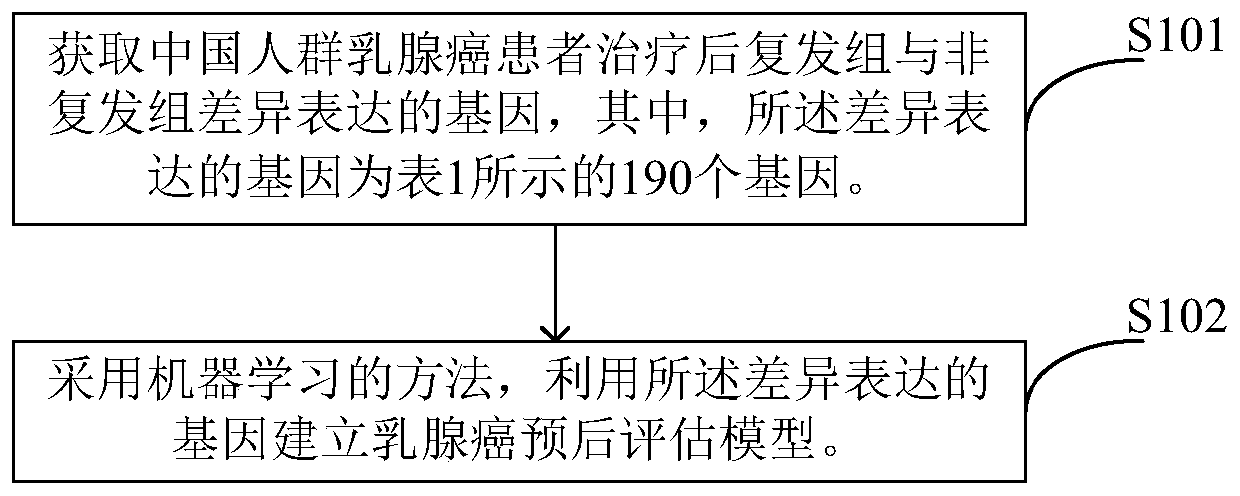Breast cancer prognosis evaluation model and establishing method thereof
A technique for prognostic assessment and establishment of methods, applied in the field of high-throughput sequencing, which can solve the problems of affecting test results, inaccurate quantitative qPCR results, and inability to identify splice mutation allele-specific mutations.
- Summary
- Abstract
- Description
- Claims
- Application Information
AI Technical Summary
Problems solved by technology
Method used
Image
Examples
Embodiment 1
[0046] Based on the above research results, this application proposes the application of a gene combination in establishing a breast cancer prognosis assessment model, and the gene combination is shown in Table 2.
[0047] The 190 genes in Table 2 are closely related to recurrence or not. Using these 190 genes to establish a prediction model for the risk of breast cancer recurrence in the Chinese population will help improve the prediction accuracy of the model constructed, and further contribute to China's breast cancer recurrence risk. Patients with early-stage breast cancer provide more accurate individualized treatment effect prediction and 10-year recurrence risk prediction, so that high-risk groups will not suffer from rapid disease progression due to insufficient postoperative adjuvant chemotherapy, and low-risk groups will not suffer from excessive treatment. The body bears unnecessary toxic and side effects of chemotherapy, and even shortens the disease-free survival p...
Embodiment 2
[0049] In another typical embodiment, a breast cancer prognosis assessment model is provided, and the model includes 190 differentially expressed genes shown in Table 2 between the recurrence group and the non-relapse group. This model can provide more accurate individualized treatment effect prediction and 10-year recurrence risk prediction for Chinese patients with early-stage breast cancer, so that high-risk groups will not experience rapid disease progression due to insufficient postoperative adjuvant chemotherapy, and low-risk groups will not experience rapid disease progression. The body suffers unnecessary toxic side effects of chemotherapy due to overtreatment.
[0050] In the above model, the P value of the differentially expressed genes can be selected to be less than 0.05.
[0051] The above model is established based on the sequencing data of genes that are significantly differentially expressed in the relapse group and the non-relapse group. Therefore, any method ...
Embodiment 3
[0053] In a preferred embodiment of the present application, a method for establishing a breast cancer prognosis assessment model is proposed, such as figure 1 As shown, the establishment method includes:
[0054] Step S101, obtaining the differentially expressed genes between the recurrence group and the non-relapse group of breast cancer patients in the Chinese population after treatment;
[0055] Step S102, using machine learning method to establish a breast cancer prognosis assessment model using differentially expressed genes; wherein, the differentially expressed genes are 190 genes shown in Table 2.
[0056] The model uses the method of machine learning to use the differentially expressed genes in two groups of known recurrence and non-relapse samples as the training set for training and learning, so as to establish a model that conforms to certain rules. Using this model can accurately provide more accurate individualized treatment effect prediction and recurrence ri...
PUM
 Login to View More
Login to View More Abstract
Description
Claims
Application Information
 Login to View More
Login to View More - R&D
- Intellectual Property
- Life Sciences
- Materials
- Tech Scout
- Unparalleled Data Quality
- Higher Quality Content
- 60% Fewer Hallucinations
Browse by: Latest US Patents, China's latest patents, Technical Efficacy Thesaurus, Application Domain, Technology Topic, Popular Technical Reports.
© 2025 PatSnap. All rights reserved.Legal|Privacy policy|Modern Slavery Act Transparency Statement|Sitemap|About US| Contact US: help@patsnap.com


